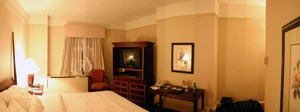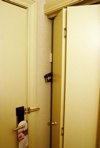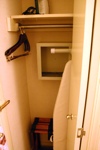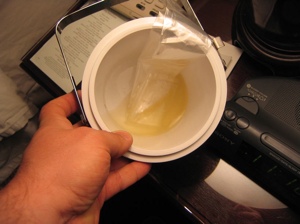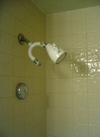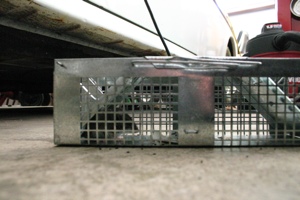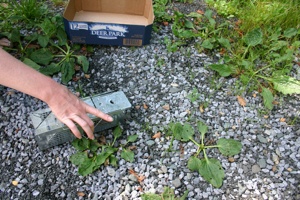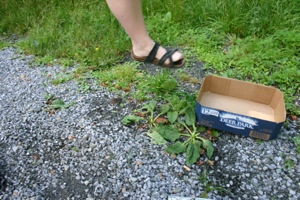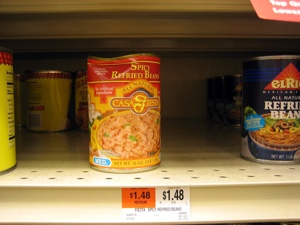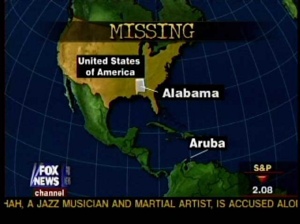
|
|
|
Thursday 30 June 2005
Customer Service
Adventures As A Retail Consumer So this morning, while drinking the tea and eating the croissants etc., I saw in the Wall Street Journal that the Slingbox is out, and that it’s apparently good. If you’ve never heard of the thing, the Slingbox is a device that plugs in, on one end, to your TV signal, and on the other to the Internet. You can then watch TV — your TV, with your normal channels, your Tivo recordings, anything you normally have at home — from anywhere in the world where you have a decent network connection. This morning’s review was written by Walt Mossberg, the Journal’s technology guy. What makes this important is that Mossberg is one of the very few technology reviewers who can be relied upon to write bad reviews when the products deserve it. Anyway, Mossberg said the thing was great, so I went out to buy one. The review specifically said:
Well, that’s easy enough. When I was passing Best Buy, I stopped in and was soon asked by one of their computer-department guys whether I was finding everything I needed. I said no, actually, that I was having a hard time finding this Slingbox thing. This produced an immediate reaction. “What is that?” he said. “You’re the fifth person who’s asked me about that thing today.” I handed him the copy of the Journal that I was carrying. He skimmed the column, and then told me he’d never heard anything about the device. Another win for Best Buy! The Mossberg column very favorably reviews a product and says that it’s available starting today at Best Buy, and the Best Buy people have never heard of it! You just can’t buy advertising like that. Lovely, but not surprising. I checked the CompUSA website, which said that they had the thing in stock in all of their Northern Virginia stores. I stopped by there in the afternoon, looked at all of the likely shelves, and came up empty. I found a CompUSA guy and asked him whether they had this thing, and I got the same flash of recognition that I’d seen earlier at Best Buy. “Slingbox!” the guy said. “I think we probably have those.” He led us over to a mirrored door and went in. He returned a few seconds later with a man with spectacularly bad hair; he looked like he was ready to attend a 1970s-themed party later tonight. I mean, it was bad. The guy with the amazing coif was apparently the manager, because he had the keys to the Room Full Of Expensive Stuff, the same room that my laptop came out of a couple years ago. He and the CompUSA foot-soldier disappeared into the Room, and stayed there for quite a while, considering the small size of the space.
They were in there so long that I had time to get out my phone, screw around with switching it to camera mode, and take a picture of the door. After a while they came back out and said that they indeed had one. It was then up to us to tell them that we were not just asking out of curiosity, but that we were interested in buying the thing. The manager went back into the Room and produced a Slingbox, which we then bought. I will have video of the device in action tomorrow, but for now let me just say that it is Teh Awesome. The only problem is that the client software requires the use of some bizarre operating system (“Windows XP”), and that the installation procedure is as bad and annoying as most installations on that painful OS. For now, I’d just like to record the idiocy of these two companies, Best Buy and CompUSA. They had free publicity in the Wall Street Journal for a product that is, for the moment, available only from those two retailers. One of them had never even heard of the product, and the other had carefully hidden the things in the stockroom, lest someone buy them. Is there no one at CompUSA and Best Buy headquarters who reads the Wall Street Journal? Wouldn’t it seem obvious that when your company is specifically mentioned as one of two exclusive sellers of a product that’s well-reviewed by one of America’s most-respected technology writers, in the newspaper with the country’s biggest circulation, that you might just send and e-mail to all the store managers, telling them to prepare to actually, you know, sell the thing? I suppose not. Which is why I don’t work in retail management: clearly I don’t understand what the business is about, naively believing that it’s about selling products. Tomorrow: video of the Slingbox in action! Posted by tino at 23:16 30.06.05
Tuesday 28 June 2005
Monday 27 June 2005
Random Photograph
100 Degrees In The Shade Booths are being set up for next week’s Fair St. Louis, which used to be the VP Fair until it was decided that that wasn’t inclusive enough. Posted by tino at 11:19 27.06.05
Sunday 26 June 2005
Review
Westin Great Southern Hotel, Columbus, Ohio We recently passed through Columbus, Ohio, and we stayed at the Westin Great Southern Hotel there. On balance it is Not Recommended. The Good:
The Bad:
The Westin Great Southern Hotel was built in the 1890s as the Great Southern Fireproof Hotel and Opera House. This fact leads directly to two of the problems with it, one really a quibble and the other quite important. The lobby is today fitted with (I believe) a reproduction of the original chandelier. In keeping with the up-to-dateness (in 1897) and fireproof-ness of the whole building, the chandelier ran on electricity, not gas. The Westin people are to be applauded for maintaining this special feature of the building, but the truth is that the thing gives terrible light. Imagine 100 clear-glass (i.e. not frosted) light bulbs hanging about 30 feet off the floor and lighting a room that’s probably 100 feet square. In case you can’t imagine that, let me inform you that by today’s standards, it’s terrible light. It looks like the building was originally built with a glass roof on the lobby: this must have improved matters greatly. Today, the ceiling is composed of milky glass panels with what seem to be fluorescent tubes behind them. Unless you are the kind of person who hangs out in hotel lobbies all day, this isn’t a big problem: but it leads to a bad first impression as you come through the door. The second, and major, problem that comes from the building’s age is the size of the ordinary guest rooms: they are absurdly small, smaller than you’d find in the cheapest motel out on the interstate. This is not uncommon with old hotels: back in the day, king-size beds were not common, and I get the distinct impression that hotel rooms were altogether more spartan than they are today. When you try to cram a television (in its giant armoire), a huge bed, an armchair, a desk, etc., etc. into a hundred-year-old room, you run out of space in a hurry. This super-wide-angle panorama makes the room look much larger than it is: There’s not enough room between the (very shallow) desk and the bed to fit a chair in there; there’s nowhere to put your bags where you’re not going to trip over them. And the closet… well, the closet is just ridiculous: The closet is so shallow that all you can do with it is hang a couple of things sideways, i.e. with the hangers turned so they are more or less parallel to the rod. Most of the space in there, though, is taken up with an ironing board, a luggage-rack that can’t be used in the room for a lack of space, and what I can only assume is a safe without a door: What you’re supposed to do with an ironing board in this room, I don’t know: set it up in the corridor, perhaps. They may as well give you a javelin in case you wanted to practice throwing it in there. So the room is too small. This is annoying, but I can’t really complain about it too much. The room was built over a hundred years ago, when people used it much differently from the way they do today (most of the rooms in the hotel originally didn’t have their own bathrooms, to begin with). Unless you tear out walls and turn every pair of rooms into a suite of two small rooms (which would be impractical), the options are: tear down the building or put up with the dimensions. On balance, I’m glad they left things alone. The remaining problems, though, are entirely the result of Westin’s inattention to detail. First, the mysterious liquid. After we’d been there a little while, I grabbed the ice bucket to participate in that great American hotel ritual, The Getting Of Ice. All American hotels, no matter how grand or how humble, provide unlimited free ice to guests: and I have never stayed in a hotel so fancy that the guest was not free to fetch his own ice from a machine stashed somewhere near the elevators. People will put up with hotels charging $2 for a local phone call, but a place that didn’t offer vast quantities of ice gratis would soon find itself out of business. Canadians scoff, but most of the United States is quite a hot place, and the business with the ice is one of the things that knits us together as a nation. So there I am, humming ‘America The Beautiful’ to myself and thinking about Free Markets and Apple Pie, when I hear a sloshing noise from the bucket. Upon inspection, it turned out that someone — possibly Osama himself — had left a few ounces of some yellow liquid in the bucket. Upon closer inspection, the liquid smelled faintly of whiskey, so it wasn’t too horrible. Note, however, the new ice-bucket condom that had been draped over the edge: someone on the Westin staff had ‘serviced’ the bucket without even checking to see whether someone had left, say, a turd in there. A call to the front desk established that there were no other ice buckets in the hotel. Apparently they have n buckets, where n is the number of rooms in the place. Whatever. After a long and drawn-out process, it emerged that there actually was another ice bucket somewhere, and that it would be sent up. After about 35 minutes of what I presume was a frantic search through a vast pyramidal pile of assorted Hotel Equipment in the basement, a new ice bucket arrived along with vouchers for two free breakfasts. So far, so-so, I suppose. We got the ice (the new bucket was delivered empty for some reason, possibly so we wouldn’t miss out on the thrill of pushing the button on the ice machine for ourselves and succumb to the temptations of Socialism) and drifted off to sleep listening to the gentle sounds of melting. Morning came, as morning will, and we once again found ourselves conscious. We were anxious to get out of that room, because it wasn’t really big enough for anything but sleeping and maybe a little ice-melting. I had set up my computer in the bathroom, partly because the counter in there was the largest flat surface available, and partly because the two free electrical outlets in there represented fully half of the free electrical outlets in the room. Now, I’m a nut: I know this. I travel with my own power strip, because no hotel room has enough outlets for me. In addition to my computer, I carry three cameras, two cell phones, one Bluetooth headset, a wireless access point, a PDA, another computer, and an iPod, all of which have batteries, and all of which are products of the Connector Conspiracy inasmuch as each one requires a power adaptor that is fundamentally identical to all the others, but that produces a minutely different voltage and has a unique and strange connector on the end. I can economize, if necessary: the iPod and one of the cell phones can be charged, in a pinch, by being connected to the Firewire and USB ports of my computer. When I’m spread out, though, I need at least ten AC outlets to power all my stuff. This room had four, two of them behind large or awkward pieces of furniture and the other two in the bathroom. There was no outlet, for instance, anywhere near the 16-inch-deep ‘desk’. As I said, we were anxious to get out of there, so I hauled a couple armloads of electronics out of the bathroom in order to convert the room from a little tiled office and into a Place Of Ablution. (The fact that there was no network jack in the bathroom wasn’t a problem, because the whole hotel is equipped with wireless Internet access. But that wasn’t an issue anyway, because I was using my Verizon BroadbandAccess card, because Westin charges you for network access on guest-room floors. It’s free in the lobby, so if you want to just wander in and suck up the bandwidth, that’s fine: but people who are paying the Westin $200 a night and up for lodging are not afforded the same convenience in their rooms. Interesting approach, that.) Anyway, it was after unloading the computers that I discovered the business with the shower head. Westin has this whole ‘heavenly’ thing going on: the bed, which in contrast to most hotel beds is not horrible and uncomfortable, is the ‘Heavenly Bed’. The bath, similarly, is the ‘Heavenly Bath’. They even provide a ‘Heavenly Bath’ bathrobe — one, mind you, in a room with a king-size bed — as part of the deal. Another part of the ‘Heavenly Bath’ thing, apparently, is that the rooms are fitted with not one but two shower heads. Unfortunately, in this room one of the shower heads was missing all together. This wouldn’t really be a problem on its own. After all, I usually shower with only one shower head. Surely, you cry, I could manage to tough it out! Well, I could have (and, as it happens, did), but this missing shower head was a bigger problem than that. It had just been broken off the stalk, leaving its water supply to dribble out at my feet. The resulting loss of pressure from the remaining shower head meant that I wound up doing a lot of gathering of water in cupped hands and then pouring it over myself. Things break; I understand that. And I even understand how this particular shower head broke, because the remaining and presumably identical shower head was already cracked and on its way to failure, too. What I do not and will not understand is why this missing shower head was left to be discovered by me, a paying guest. The room had obviously been cleaned, and the bed made, before it was rented to me: why the hell had this missing shower head (and the problem with the ice bucket) not been discovered and fixed before I showed up? Just what am I paying for? And all this is in a fairly expensive hotel, run under a brand that’s trying hard to be seen as the finest hotel chain in America that’s not gone in for the bath-butler school of false and useless ‘luxury’. After rinsing off most of the soap, we headed down to for our free breakfasts. About that, let me say this: had I been paying for these breakfasts, I wouldn’t have. The food was bland, and served in a fairly gloomy room. There was a fairly long wait (considering the emptiness of the room, and the buffetness of the breakfast) to be seated, and then to get our coffee and juice. The orange juice was bitter and acidic because it was from concentrate, and the syrup for the pancakes was corn syrup with a tiny bit of maple syrup thrown in for ‘flavor’. That’s okay, though, I suppose, because the pancakes themselves were like little wood chips — after you scraped them out of the chafing dish. These things are fine at the IHOP — or at least expected if not fine — but I expect better from a large hotel. I’m not sure, but I think they were charging in the neighborhood of $20 a head for this fantastic repast. After ‘breakfast’, we got the car from the parking lot and left. While I’m on the topic of parking, it might be worth mentioning that the hotel charges $20 a night for parking, despite the fact that it’s flanked on two sides by fairly cheap parking lots. Lord knows what they charge you for ‘valet’ parking, i.e. some guy driving your car the 150 feet from the hotel’s entrance to their own parking lot. If you don’t take advantage of the ‘valet’ parking, though, it’s inconvenient, because though the parking lot is directly adjacent to the hotel, there is no entrance to the building on that side. The main entrance is on a busy street with limited space for cars; the side entrance, where you can easily leave a car while you go fetch your luggage, involves a long, narrow corridor with non-automatic doors and stairs. The very architecture of the place makes one feel less like a valued guest and more like a mark to be squeezed for money. We complained about the shower head while checking out, and the clerk said that she’d see what she could do about compensating us for our trouble. It seemed, though, that this might be difficult because we’d booked the room through Expedia. When you do this, Expedia, not the hotel, actually charges your credit card, and I gather that it’s difficult for the hotel to do anything about adjusting your rate. In any case, you effectively get punished for booking your room that way. American Express informs us that there have been no adjustments to our charges, so I suppose that Westin assumes that either we’re not worth having as customers, or that this is about the experience that one is to expect from the Westin Great Southern. Total damages: $187.68 + $20 for parking = $207.68. A poor value. Update: Apparently the Westin people agree that it was a poor value, because they’ve decided to refund our money. This is unnecessarily complicated, though: see Nicole’s comment below. Posted by tino at 22:54 26.06.05
Thursday 16 June 2005
General Idiocy
Cell Phones On Planes In a Boston Globe story today about the griping of people who are against allowing people to use their cell phones in airplanes, one particular quote stands out:
Mr. Owens is represented as a pilot, so we may assume that he has been in an airplane. Yet he thinks that the incredible noise of people talking on cell phones will distract the crew. Apparently the mind-numbing wind and engine noise you already have inside an airplane isn’t a problem. I see. Posted by tino at 21:05 16.06.05
Random Interesting Thing
Mouse Attack! Recently, some mice have taken up residence here at Tino Manor, and we have been reduced to trapping them and removing them.
Eek! A mouse! Eek, still. It must be remembered that Nicole just let the mouse out of the trap, so it’s not as if she were surprised by its presence. What you’re seeing here is the power of just the proximity of a known mouse. Posted by tino at 14:29 16.06.05
Tuesday 14 June 2005
Spam
Spam Way Down The spam has been down, way down (talk to your wife). With the exception of a couple spikes, for the last week I have been holding steady at about five per hour.  This graph only counts things that get through to the spamfilter, meaning things that are not caught by IP blacklists and a few simple header checks for virus attachments. Still, it’s a dramatic reduction. Posted by tino at 11:17 14.06.05
Customer Service
The Curse Of Abundant Choices The lovely and talented Don Boudreaux comments on a letter that appeared in the New York Times. The letter was written by a correspondent in McLean, Virginia, one of the world’s wealthier places and a suburb of Washington, DC. It’s impossible to really tell how much irony went into the letter, but for the moment we’ll take it at face value. Boudreaux quotes the whole thing, but here’s a short excerpt. It’s in response to a column about super-abundance in the United States, particularly focusing on the startling diversity of dental flosses that are available. The Times’ reader writes:
Boudreaux scoffs lightly at the plight of the would-be orange-juice consumer in McLean. Now, I don’t really care what kind of garbage the O.J. Trusts are selling in their paper containers: I don’t pay attention, because unless it’s fresh-squeezed, it all tastes horrible to me. The goodness of orange juice doesn’t survive pasteurization, and nearly all orange juice is pasteurized these days. I do, however, pay attention to milk, because I use milk in my tea and on my Grape Nuts (when Grape Nuts are available, that is). The dairy case, like the dental aisle and the orange-juice department, has exploded in recent years. I have my choice of milk, 2% milk, and skim milk; I can get all of those pasteurized, ultra-pasteurized, or organic (which is usually also ultra-pasteurized). I can get each of them with regular or low carbs; I can get them with or without enzymes for the lactose-intolerant. I can even get ‘milk’ that actually has no milk at all in it, having been squeezed from the teats of soybeans in a process I don’t care to contemplate. I can get them in regular, chocolate, or strawberry flavors, and I can get them all in half-pints, pints, quarts, half-gallons, or gallons. And despite the government’s price supports, I can get all of them for remarkably low prices. 
When I can get them at all, that is. I prefer quarts of whole non-ultra-pasteurized milk. The ultra-pasteurization cooks all the flavor out of the stuff, and when you use a couple ounces of milk a day it doesn’t pay to buy it more than a quart at a time. Unfortunately, whole milk in quarts seems to be almost totally unavailable here. There’s room for it on the shelf, but there’s only something there about one in five times that I look. The milk cooler at my local supermarket is about 30 feet long, meaning that it’s got 150 linear feet is shelving for products, but the only things that are reliably available there are the soy milk (which is not in much demand) and the gallons of whole milk (which are something of a commodity and are thus stocked in enormous quantities). I’ve written before about the unreliability of my supermarket, and this is just another example. I’m all for an abundance of choice, but I am alarmed at what seems to be the usual practice of neglecting the tried-and-true classic choices that have a proven market in favor of something new. We need the new! We want the new! Bring on the choco-strawberry low-carb, no-fat, semi-gelatinous non-dairy soy-based beverage with added calcium! Suspend globs of candy in the stuff if you like! See whether people will buy the stuff, and congratulations to you if they do. You deserve your marketing-department bonus, because you have made the world a better place. In the process, however, it’s important not to over-extend your company to the point where you cannot manage to supply those products that sell consistently and in volume with no expenditure on research or advertising. If you have twenty different kinds of dental floss but only twice the shelf space you used for two kinds of dental floss back in the Dark Ages of only Mint and Unflavored, you are ten times more likely — assuming perfect distribution of both supply and demand — to run out of any one variety before you restock. Looked at this way, this abundance of minutely differentiated products doesn’t look like such a great idea unless you can inexpensively and competently manage to supply or sell a greater number of individual products than before. It’s a pity that few companies seem to be able to do this. Posted by tino at 11:03 14.06.05
Monday 06 June 2005
Customer Service
Reston Panera So I’m at the Panera Bread in Reston again, and guess what’s not working? The air conditioning. It’s over 90 degrees outside, too. Also the network. Luckily I gave up on the Panera network a while back and bought a Verizon BroadbandAccess card. Most of the staff are watching a customer-service training video of all things in the back of the place. Posted by tino at 17:02 6.06.05
Saturday 04 June 2005
Customer Service
Martin’s Is Out Of Grape Nuts Again Last week I wrote about the challenges of grocery shopping in Front Royal — particularly the challenge of actually buying something as exotic as Post Grape Nuts cereal. When I wrote that, my grocery store actually had Grape Nuts in stock. No more.
That hole on the shelf there is where the Grape Nuts should be. Plenty of South Beach Diet Flakes, though. There’s always plenty of shelf space given over the stuff that nobody wants. It took them less than ten days to sell out; we’ll see how long it takes for Grape Nuts to reappear. They did have beans: Though of course if you didn’t want the dented ones, you were out of luck. With the aluminum cans they’re using these days, you can only open one end: the top. So getting the beans out of this can will require a chisel or something. And God forbid you should want non-ultra-pasteurized whole milk by the quart: The ultra-pasteurized milk lasts for a month, but it doesn’t taste like anything. Since I only use milk for tea and Grape Nuts (and hence don’t use all that much milk, viz. comments about Grape-Nut availability above) if I buy more than a quart at a time, it spoils before I finish it. I can understand running out of things from time to time, but the reality is not that they’ll run out of things occasionally, but that occasionally they’ll surprise you by actually having things in stock. Posted by tino at 17:39 4.06.05
Friday 03 June 2005
Customer Service
How Not To Do It: Customer Service In An Age Of Fraud Apple’s .Mac service says they want me back, but they have a funny way of showing it.  I like to consider that I’m a pretty savvy person, without being paranoid. I’ve been abused of a couple of times by sleazy online merchants, but I’ve never actually been ripped off, nor have I ever been the victim of ‘identity theft’. I have never used any anti-virus software on Windows, and yet I have never actually had a virus infection on any of my computers. If you pay just a little bit of attention, you can get through life mostly unscathed. On Tuesday, though, I was very busy: I was up to my ears in work, and literally talking on two phones at once like a tycoon in an old movie: ‘Buy Steel!’ ‘Sell Radio!’ ‘Get Wilkins in here with the Schenectady numbers!’ etc. While all this tycooning was going on, my cell phone rang with ‘Unknown’ showing on the caller ID. I’m now on three phones at once. The guy on the other end said that he was Steve, from Apple Computer, and he asked whether I’d like to renew my recently-expired trial .Mac account. It’s hard to explain just what .Mac is; mainly, it’s a scheme by which Apple can get $99 a year out of you. For your money you get an e-mail account, space on a web server, private online storage space for your files, and a few other things. It’s actually a good deal if you make use of all of it: as it is, I need almost none of this. I already have my own e-mail and web server, and over a terabyte of on-line storage in the basement. A few features, though, are difficult to duplicate. Macintoshes come with a program called iSync, which is superficially a utility to sync your phone or your PDA with the information on your computer. iSync also can sync the information on multiple computers, which is what I’m interested in. I have a laptop and a desktop computer, and I use them pretty interchangeably. The challenge is keeping the web browser bookmarks, address books, an calendars on each machine in sync. With some programs, this wouldn’t be a problem: you could just send files around. Apple’s Safari web browser, Address Book, and iCal programs — which I use because they don’t annoy me, which is something like high praise — deliberately make this difficult, because Apple wants that $99 a year. It’s hard to do unless you pay $99 a year to use all of iSync’s features, in which case it becomes incredibly easy. Apple’s products are of such a high quality, and please their users so much, that Apple can afford to occasionally throw a monkey wrench like this into the experience. After all, what am I going to do if I don’t like it? Use Windows or Linux on the desktop? In order to save $99 a year, I’m going to screw around with Windows? I hardly think so. So I got a free 60-day trial of .Mac when I bought my most recent computer, and the time had come either to pay or to give it up. I hadn’t made a decision. Until that guy called on the phone, that is. What the hell, I’d renew. But I asked: is there any advantage to renewing with the phone solicitor rather than online? I’d get three times the on-line storage (1 GB vs. 250 MB), he said. I don’t consider that much of a bonus — 25% off the price would be a bonus — but all right, fine, I’ll pay. I had tired of trying to roll my own .Mac. I gave the guy my credit card number, the (mis)spelling of my name as it appears on the card, and my billing address. He then told me that the charge would appear on my card as ‘Apple Computer’, that a confirmation e-mail would be sent to my .Mac e-mail address, and that tomorrow afternoon — that is, Wednesday — I should log in to the .Mac service via the mac.com web site, and that my password would be changed to ‘password’ to facilitate this. After I’d got off all the phone calls, I thought about this for a while. It smelled fishy. To begin with, why on earth would this process take more than 24 hours? And why should it involve resetting my password, particularly to something so predictable? I already had a password; all they’d have to do is set my account status to ‘active’ after charging my card. And why on earth would they send a confirmation e-mail to an address that I wouldn’t have access to unless the transaction succeeded? I can think of plausible answers for all of these questions that don’t involve attempted fraud, but I can also think of plausible answers that do involve fraud. So I had just given my credit-card details to someone based solely on the fact that he knew three things:
Further, Apple’s own .Mac privacy policy says ‘Apple will not contact you or share your information unless you authorize it’. Now by this they probably mean that they won’t subject me to endless phone spam attempting to sell me other stuff, but the policy doesn’t say that. The policy says ‘Apple will not contact you’, and here was someone representing himself as being from Apple, contacting me. I tried to find some way to contact Apple about this, but the only way to contact the .Mac people in any way appears to be a web form here. They say that their ‘service experts’ will ‘make every effort to reply’ within 48 hours. I filled out the form, asking whether they actually used phone solicitors to sell account renewals. For good measure, I then called my bank and cancelled my credit card. The next afternoon (Wednesday), my cell phone rang again with an ‘Unknown’ caller ID. I answered, and sure enough, it was ‘Steve’ with Apple again. He said that the credit card number I’d given him had been declined, and did I have another one they could use? I mean, those were very nearly his exact words. I asked him whether there was a phone number at which I could call him back, and he gave me 1-800-385-5172, extension 535. This phone number does not turn up in Google (or at least it won’t until I post this). I called this number and was met with a recording that said hello from Apple, and said that I should enter an extension number or stay on the line. I stayed on the line, and a few seconds later was talking to a woman who’d answered the phone with something akin to ‘.Mac customer support’. I asked for extension 535, and in a couple seconds I was talking to Steve again. I then laid out the story for him. I apologized for essentially accusing him of being a scam artist, and said that the whole situation seemed suspect to me, and that I had cancelled the credit card. I specifically mentioned the extreme fishiness of resetting my password to ‘password’; he defended this practice by saying ‘that’s what we do for everyone’. This is hardly reassuring, to say the least. If you forget your login password for Apple’s online discussion boards there’s better security. Steve was pretty defensive in general. If he was a scam artist, he asked, how would he know my mother’s maiden name? He told me my mother’s maiden name for verification. I told him that had there been a data security breach at .Mac, all of this information could be readily available to him (and that the mother’s-maiden-name thing is hardly secure anyway). I told him that I could think of no simple way that he could convince me of his legitimacy, and that given the thing with resetting the password to ‘password’, that I wasn’t sure I wanted to have anything to do with .Mac even if he was legitimate. I then wished him a nice day and we parted ways. On Thursday at 2:51 p.m., I got an e-mail in response from my online .Mac support query. My exact query to them was:
I have to present their response to me as a graphic, instead of text. Click on the picture for a bigger version. 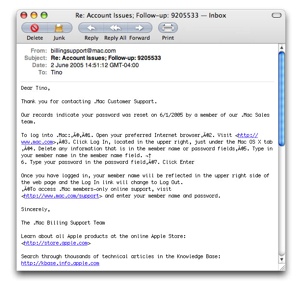 The headers on this message show that it originated with a computer calling itself snowy.corp.apple.com with an IP address of 17.254.13.36. All IP addresses beginning with 17. are in Apple’s address space, so this probably comes from within an Apple network. (This address actually resolves back to A17-34-112-122.apple.com, not snowy.corp; but that’s not unusual.) Interestingly, the e-mail headers seem to indicate that that computer is running AIX, which is to say IBM Unix. Apple doesn’t eat its own dog food. So anyway, while the message is probably legitimate, it hardly inspires confidence, what with its strange line breaks and odd high-ASCII garbage (this is how the message displays in Apple’s own Mail.app program, so claims of character set incompatibilities and so forth will hold no water). In fact, if I didn’t know how to read e-mail headers, this message would have absolutely convinced me that I was being set up. So this phone-sales guy Steve was probably on the level, and I’ve gone through the hassle of canceling that credit card for nothing. But I think that this experience occasions the establishment of an annex to the Customer Service Rules, specifically for these kinds of situations. If you are in a position of ever calling customers and asking them for information:
And finally, less of a customer-service rule than a general guideline for everyone: never, ever, ever set a password to ‘password’. I mean, really now. Not only do you make yourself look silly by even suggesting such a thing, but you set yourself up for sabotage and, if you’re doing it for your customer (as opposed to for your own account), liability. Let’s assume for a moment that Steve is a totally legitimate Apple sales guy. Let’s also assume that Steve, or someone like him, develops some sort of animosity toward Apple. After he reset a password to ‘password’, all he’d have to do is communicate the account name to a friend of his, who could go in and replace all the existing data with goatse pictures. There’s been a lot of online-commerce punditry to the effect that the Internet levels the playing field: Joe’s Cheese Emporium can, if Joe is adept with HTML and a database, ‘look just like’ the web premises of a far larger company. This is a good thing. But Jimmy The Grifter’s Online Scam Hut can also ‘look just like’ — a lot more like, in fact — a much larger and more trusted company. In the past, Jimmy The Grifter would have had to rent space, furnish it, and spend a whole lot of money on other things in order to rip people off by fooling them into thinking they were dealing with someone else. Today, it’s trivial to pull the same scam online or over the phone. Companies in the industrial age worked to establish and defend their brand names and trademarks against impostors. Today it’s important to establish and defend your entire corporate identity, and to make sure that every single thing you do can be at least reasonably authoritatively tied back to that identity by your customers. Either you spend the money to do this now, or you spend the money later, after some public-relations disaster, trying to convince people that they can deal with your company in confidence. Posted by tino at 14:25 3.06.05
Random Interesting Thing
Vermillion Alert!
Motorists traveling on Interstates 10, 20, 59, 65, and 85 are advised to use caution when approaching Alabama, as the state has been reported missing.
In unrelated news: Malibu plagued by jazz ninjas. Film at 11. Posted by tino at 11:23 3.06.05
Thursday 02 June 2005
Media
Specialization, Journalism, and Professionalism A few days ago, I wrote a fairly amorphous thing about professionalism, mainly to get down some things that had occurred to me as a prelude for more specific rants. The thing that initially got me thinking about this was the rise of professional town planning (as opposed to such planning being an offshoot of architecture or engineering). Unless you’ve been living under a rock for the past year or so, though, you’ll have noticed that a lot of people have been complaining about the failings of ‘professional’ journalism, and that a lot of ‘professional’ journalists have been complaining about ‘guys in pajamas’ horning in on their racket. Recently, the American Press Institute’s Media Center blog had something to say about this. It’s primarily about the difficulty that the news media seem to have in adapting to changing technology, but the ideas apply more generally, and to just about any fraudulent ‘profession’. I find it quite interesting that they too seem to see ‘professionalism’ as an obstacle here:
Resistence to technology is an interesting topic, too, but this idea of defensive occupational paralysis makes me think more generally of the recent problems at both Newsweek and CBS News. About a month ago, Newsweek printed a short blurb about alleged ‘Koran desecration’ at Guantanamo Bay, a blurb which it subsequently retracted and apologized for after it turned out that the story was untrue, at the very least as it was presented by Newsweek. This all became big news after deadly anti-American riots erupted in Afghanistan, allegedly as a result of anger occasioned by the article. Newsweek has taken a lot of heat for this, but their explanation of how it happened actually makes a lot of sense. The story had what subsequently turned out to be fairly ambiguous confirmation from within the Defense Department. Had Newsweek admitted its error and explained the circumstances quickly, I think this event could actually have enhanced the magazine’s reputation. Instead, though, Newsweek closed ranks and defended the story, retracting it only when their failure to do so began to look silly. They then went back and forth a few times, offering excuses verging on the ‘fake but true’ reasoning we saw from CBS last fall. At this point, I’m not sure what their position is. (On their website, they have now appended a ‘Newsweek press release’ to the original story, but as it is now almost a month old, you have to pay $2.95 to read what are probably the most-discussed 354 words their magazine has ever printed.) CBS News, for its part, is now experiencing record-low ratings in the aftermath of its particularly ridiculous stunt last fall involving fraudulent documents that attempted to portray President Bush’s National Guard service in a bad light. In that case, CBS stonewalled for weeks in the face of clear evidence that they had, at the very least, been duped. In both cases, CBS News and Newsweek showed that their loyalty was not to their customers nor to the truth, but to their ‘professional’ employees. True professionals by definition deserve deference: that deference, and the responsibilities that go along with it, are what makes them professionals. I fail to see, however, how such deference to news reporters is in anyone’s interest. Posted by tino at 11:03 2.06.05
|



